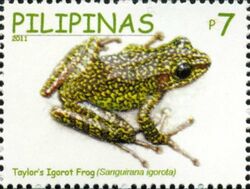Biology:Sanguirana igorota
| Sanguirana igorota | |
|---|---|

| |
| Scientific classification | |
| Domain: | Eukaryota |
| Kingdom: | Animalia |
| Phylum: | Chordata |
| Class: | Amphibia |
| Order: | Anura |
| Family: | Ranidae |
| Genus: | Sanguirana |
| Species: | S. igorota
|
| Binomial name | |
| Sanguirana igorota (Taylor, 1922)
| |
| Synonyms[2] | |
| |
Sanguirana igorota is a species of true frog, family Ranidae. It is endemic to Cordillera Central of the island of Luzon, Philippines .[1][2] Its closest relative is Sanguirana luzonensis, and it has even been considered synonym of that species;[2] a later study suggests still unresolved relationships between S. igorota, S. luzonensis, and S. tipanan.[3] Common name Taylor's Igorot frog has been coined for this species.[4]
Description
Adult males measure 50–58 mm (2.0–2.3 in) and adult females 68–82 mm (2.7–3.2 in) in snout–vent length.[3] The snout is squarish in dorsal view.[3][5] The tympanum can be translucent.[3] Moderate dorsolateral ridges are present. The dorsum is olive green with bronze spots. The venter is yellow.[3][5] Fine dorsal asperities are present. The groin is tuberculate. No vocal sac is present in males.[3]
Habitat and conservation
Sanguirana igorota occurs in cool streams and rivers in montane rainforest at elevations of 850–950 m (2,790–3,120 ft) above sea level[1] (800–1,300 m (2,600–4,300 ft) in other sources[4]). It can be fairly abundant in suitable habitat and tolerates some habitat disturbance. Presumably, breeding takes place in streams; the eggs are laid in water. It is threatened by habitat loss (deforestation) caused by habitat conversion to agriculture or real estate.[1]
References
- ↑ 1.0 1.1 1.2 1.3 IUCN SSC Amphibian Specialist Group (2018). "Sanguirana igorota". IUCN Red List of Threatened Species 2018: e.T58623A58481206. doi:10.2305/IUCN.UK.2018-2.RLTS.T58623A58481206.en. https://www.iucnredlist.org/species/58623/58481206. Retrieved 20 November 2021.
- ↑ 2.0 2.1 2.2 Frost, Darrel R. (2018). "Sanguirana igorota (Taylor, 1922)". Amphibian Species of the World: an Online Reference. Version 6.0. American Museum of Natural History. http://research.amnh.org/vz/herpetology/amphibia/index.php//Amphibia/Anura/Ranidae/Sanguirana/Sanguirana-igorota.
- ↑ 3.0 3.1 3.2 3.3 3.4 3.5 Brown, Rafe M.; Prue, Allyson; Onn, Chan Kin; Gaulke, Maren; Sanguila, Marites B.; Siler, Cameron D. (2017). "Taxonomic reappraisal of the Northeast Mindanao Stream Frog, Sanguirana albotuberculata (Inger 1954), validation of Rana mearnsi, Stejneger 1905, and description of a new species from the central Philippines". Herpetological Monographs 31 (1): 210–231. doi:10.1655/HERPMONOGRAPHS-D-16-00009.1.
- ↑ 4.0 4.1 Diesmos, Arvin C. (2 Sep 2014). "The Igorot frog". Philippine Daily Inquirer. https://www.pressreader.com/philippines/philippine-daily-inquirer/20140902/282694750343720.
- ↑ 5.0 5.1 Brown, Rafe M.; McGuire, Jimmy A.; Diesmos, Arvin C. (2000). "Status of some Philippine frogs referred to Rana everetti (Anura: Ranidae), description of a new species, and resurrection of Rana igorota Taylor". Herpetologica 56 (1): 81–104.
Wikidata ☰ {{{from}}} entry
 |


